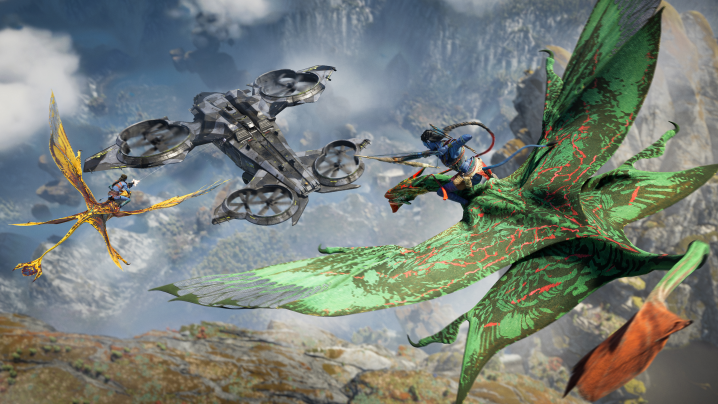“Avatar: Frontiers of Pandora can't put its human nature aside long enough to properly honor the Na'vi.”
- Beautiful recreation of Pandora
- Some thoughtful Na'vi gameplay
- Tense stealth
- Natural world activities
- Gunplay feels out of place
- Story never pays off loaded premise
- Gluttonous design
- Frustrating looter shooter system
Avatar: Frontiers of Pandora’s protagonist is torn between two identities. They’re a true-blue Na’vi descended from a race of peaceful forest dwellers, but that proud heritage is complicated by the fact that they were kidnapped by humans as a child and thrown into an experimental military program. That makes for quite the personal crisis when they escape their villainous Resources Development Administration (RDA) captors and return to the beautiful world of Pandora. How’s a gun-toting hacker supposed to fit in among the trees?
It’s perhaps fitting then that Ubisoft’s latest open-world adventure reflects that same confusion in its design. On one hand, it’s a thoughtful Na’vi journey where players learn to live in harmony with the natural world. Its best moments play like a gentle survival game about carefully living off the land. Of course, peace doesn’t make for a thrilling blockbuster, so it’s also a rowdy first-person shooter filled with slick headshots and loud explosions. It’s two distant halves uneasily stitched together like Frankenstein’s monster.
Avatar: Frontiers of Pandora tries to have its cake and eat it too. It wants to respect James Cameron’s cinematic vision by adapting Na’vi culture to an interactive medium while still packing in every open-world action trope possible. For a story about a race that only takes what it needs from nature, Frontiers of Pandora sure seems obsessed with excess.
Pandora comes to life
Frontiers of Pandora adapts the Avatar film series into a video game for the first time since 2009’s poorly received Avatar: The Game. The 2023 redo is a much bigger, and more successful, project that pulls in the expertise of Tom Clancy’s The Division studio Massive Entertainment. The developer makes a strong case for why Avatar perfectly fits into an Ubisoft open-world framework. Crafting, cooking meals, harvesting materials, bartering with vendors, building reputation with factions, tracking trails using a special sense — all of these are standard genre staples that actually seem like things the Na’vi people would do.

While they are formulaic, Massive thoughtfully considers how to tweak some of those ideas to fit the race’s ethos. When snagging a fruit off a tree, players don’t just quickly press a button and gobble up as much as possible. Instead, doing so triggers a quick minigame where they have to carefully pluck the resource to make sure none of it goes to waste. The Na’vi believe that their planet is sacred and Massive goes the extra mile to make sure that’s respected.
That guiding philosophy only works as well as it does because of Pandora itself, which is an achievement for the open-world genre. The massive planet is intricately detailed, loaded with vibrant flora that decorates every inch of land. It’s a sprawling map filled with multilayered vertical spaces, deep caves, and floating islands that perfectly captures the awe-inspiring beauty of Cameron’s filmic world. Even after finishing it, I’m sure I only saw a small fraction of its picturesque vistas.
That grand design isn’t a superfluous way to fill space; Frontiers of Pandora wants players to truly learn the ecosystem. Missions don’t give players exact markers to follow, but rather a set of instructions noting what landmarks their objective is near. A deep tracking system gives players intel on every single plant and where to find it. Glowing trees stand in for totems that payout health upgrades or skill points, and they’re not signposted with big icons. If I want to grow stronger, I need to take the time to learn the land so I can find my way around without popping into menus – and that’s important considering that the open-world map is nearly illegible thanks to tiny UI.
It’s best enjoyed as a wilderness survival game …
I clicked with Frontiers of Pandora most when I simply got to soak in that space and live like a Na’vi. My favorite moments didn’t come from blockbuster story missions, but rather offhand ones where I’d dive toward the ground on my flying Ikran and skim past a lake’s surface so it could catch energy-restoring fish in its mouth. It’s best enjoyed as a wilderness survival game, save for a confounding energy management system that requires players to constantly wolf down meals. If Frontiers of Pandora confidently leaned into that style to create an Avatar-themed spin on something like Subnautica, it would be the perfect adaptation … but that’s just the positive side of its split identity.
Going to war
While there’s an inventive spirit in the Na’vi-centric design, Frontiers of Pandora is disappointingly unimaginative in other areas. Its serene moments of natural platforming are interrupted by first-person shooting that feels like it was plucked from another game entirely. Well, one game in particular: Far Cry.

Frontiers of Pandora clones that series’ DNA to build the foundation for its Hollywood action – and it’s a jarring decision. Most major story missions have me sneaking into an RDA base and sabotaging their world-polluting operations by blowing up pipelines and shutting down gas valves. When I’m playing stealthily, I’m suddenly a killing machine headshotting unsuspecting humans with arrows. And when things get loud, I pull out my assault rifle and start emptying clips into a small handful of reused mechs. It’s a (ahem) far cry from the peaceful exploration that won me over.
My tragic backstory feels like it exists as a convenient way to keep gun violence at the forefront …
It’s not that the core action loop isn’t “fun.” The combat builds on Sony’s Horizon series with satisfying archery that lets me take down RDA goons with deadly precision. Outpost missions provide some exciting stealth highs too, as I silently scale mechanical towers and shut down military operations like a shadow. It all just feels so incongruous with everything the rest of the peaceful design preaches. I’m mowing down hordes of humans without a care in the world, setting them on fire by busting open exploding barrels, or electrocuting a mech pilot by tossing an electrified spear right between his eyes. It never quite fits.
There’s a world in which that feeling is both intentional and effective. Frontiers of Pandora has a strong narrative introduction that sets up a complicated journey for a hero reclaiming their stolen heritage. I figured I might shed the tools of my oppressors at some point, tossing aside my shotguns and rocket launchers for Na’vi weapons. The story never does much with that loaded setup. When I’m plopped into Pandora, I don’t spend much time unlearning my human habits and embracing my heritage. I’m a hybrid until the end, gunning down waves of humans — and even packs of wild animals whose bodies I pray over after filling them with bullets — in massive firefights. My tragic backstory feels like it exists as a convenient way to keep gun violence at the forefront of a bankable video game.
There’s a fair debate to be had about the politics of Frontiers of Pandora. One could argue that the game solves some of the problems of its filmic counterparts by centering on the Na’vi instead of human allies. Perhaps I could learn to accept it as a harmless shooter about an oppressed group rising up to reclaim its land and turning the tools of its enemies against them. It is satisfying to get to do a little eco-terrorism in a fantasy context, after all. But a larger part of me feels uneasy seeing an allegory for indigenous struggle reduced to another Westernized power fantasy.
Yeehaw, I guess.
Open-world bloat
What’s just as tiring is the bloated, templatized nature of Frontiers of Pandora’s structure. Like Assassin’s Creed or Far Cry, Pandora is loaded to the gills with “content” for the most obsessive players to pick off over time. There’s a glut of sidequests to discover, bases to conquer, and loot to collect. That’s not inherently negative. When I’m not actively trying to check sights off a list, there’s a satisfaction that comes from discovering natural points of interest tucked away in the dense world. When I come across a Na’vi totem in the wild, one that directs me around an area with woven arrows, it feels like it actually belongs in the world. The strong world design makes that discovery loop less artificial.
It’s bloated, derivative, and so undeniably beautiful that perhaps nothing else really matters.
What’s more eye-rolling, though, is just how much it repeats itself. At some point, it feels like every mission has me following a scent through the woods, fighting off some enemies or snagging loot, and fast-traveling back to a base to tie it off with a dry NPC conversation. Sometimes I have to use my senses to do a bit of deduction, which has me straining to find tiny items I can interact with strewn across a detailed forest floor. Massive even finds a way to sneak in an overused hacking minigame that feels like it was pulled straight from Cyberpunk 2077 rather than the world of Avatar.
Some tropes here feel obligatory, like they’re there to check items off a top-down design mandate. That’s especially true in its RPG looter shooter gear system, which finds Frontiers of Pandora at its most irritating. Like a live service MMO, I’m constantly picking up new gear and mods with varying degrees of rarity and some power number attached to them. Gear strength dictates my overall power level, which determines if I’m strong enough to take on a quest. That’s a deceptive stat, though. One overpowered gun might balloon my level, making me feel overconfident as I waltz into a firefight and am shredded into parmesan cheese due to my underpowered defenses. Finding proper gear is a hassle too, as side missions yield inconsistent rewards and constant crafting grows tiresome.

All of this feels inconsistent with the Na’vi code that I’m taught elsewhere, right down to a gluttonous cosmetic shop that lets players customize their character with microtransactions. Aren’t I supposed to be only taking what I need instead of hoarding rare gun mods and Ikran saddles? Frontiers of Pandora is, ironically, an avatar itself; it tries to climb inside the mind of the Na’vi, but the pilot of that body is unmistakably human.
Of course, it’s possible to ignore all of those thorny issues and enjoy the spectacle of it all. Few open worlds are as lively and inviting as Pandora, with its rich details and vibrant colors. There’s no shortage of blockbuster thrills either thanks to intense firefights in big-budget set pieces. In that way Frontiers of Pandora is kind of the perfect Avatar game after all: It’s bloated, derivative, and so undeniably beautiful that perhaps nothing else really matters.
Avatar: Frontiers of Pandora was tested on PC and Legion Go.
Editors' Recommendations
- Best cooking recipes in Avatar: Frontiers of Pandora
- The best skills in Avatar: Frontiers of Pandora
- Avatar: Frontiers of Pandora: release date speculation, trailers, and more
- Ubisoft to release Skull & Bones, Avatar game by April 2023
- New Avatar: Frontiers of Pandora trailer details upgrades to Snowdrop engine




